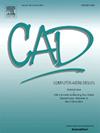LoGAvatar: Local Gaussian Splatting for human avatar modeling from monocular video
IF 3.1
3区 计算机科学
Q2 COMPUTER SCIENCE, SOFTWARE ENGINEERING
引用次数: 0
Abstract
Avatar reconstruction from monocular videos plays a pivotal role in various virtual and augmented reality applications. Recent methods have utilized 3D Gaussian Splatting (GS) to model human avatars, achieving fast rendering speeds with high visual quality. However, due to the independent nature of GS primitives, existing approaches often struggle to capture high-fidelity details and lack the ability to edit the reconstructed avatars effectively. To address these limitations, we propose Local Gaussian Splatting Avatar (LoGAvatar), a novel framework designed to enhance both geometry and texture modeling of human avatars. Specifically, we introduce a hierarchical Gaussian splatting framework, where local GS primitives are predicted based on sampled points from a human template model, such as SMPL. For texture modeling, we design a convolution-based texture atlas that preserves spatial continuity and enriches fine details. By aggregating local information for both geometry and texture, our approach reconstructs high-fidelity avatars while maintaining real-time rendering efficiency. Experimental results on two public datasets demonstrate the superior performance of our method in terms of avatar fidelity and rendering quality. Moreover, based on our LoGAvatar, we can edit the shape and texture of the reconstructed avatar, which inspires more customized avatar applications. The code is available at http://cic.tju.edu.cn/faculty/likun/projects/LoGAvatar.

LoGAvatar:局部高斯喷溅,用于单目视频的人类头像建模
单目视频的虚拟化身重建在各种虚拟现实和增强现实应用中起着至关重要的作用。最近的方法利用三维高斯飞溅(GS)来建模人类化身,实现快速渲染速度和高视觉质量。然而,由于GS原语的独立性,现有的方法往往难以捕获高保真的细节,并且缺乏有效编辑重建头像的能力。为了解决这些限制,我们提出了局部高斯飞溅头像(LoGAvatar),这是一个新的框架,旨在增强人类头像的几何和纹理建模。具体来说,我们引入了一个分层高斯飞溅框架,其中局部GS原语是基于人类模板模型(如SMPL)的采样点来预测的。在纹理建模方面,我们设计了一个基于卷积的纹理图谱,既保留了空间连续性,又丰富了精细细节。通过聚合几何和纹理的局部信息,我们的方法在保持实时渲染效率的同时重建了高保真的化身。在两个公开数据集上的实验结果表明,我们的方法在头像保真度和渲染质量方面表现优异。此外,基于我们的LoGAvatar,我们可以编辑重构头像的形状和纹理,从而激发更多的定制头像应用。代码可在http://cic.tju.edu.cn/faculty/likun/projects/LoGAvatar上获得。
本文章由计算机程序翻译,如有差异,请以英文原文为准。
求助全文
约1分钟内获得全文
求助全文
来源期刊

Computer-Aided Design
工程技术-计算机:软件工程
CiteScore
5.50
自引率
4.70%
发文量
117
审稿时长
4.2 months
期刊介绍:
Computer-Aided Design is a leading international journal that provides academia and industry with key papers on research and developments in the application of computers to design.
Computer-Aided Design invites papers reporting new research, as well as novel or particularly significant applications, within a wide range of topics, spanning all stages of design process from concept creation to manufacture and beyond.
 求助内容:
求助内容: 应助结果提醒方式:
应助结果提醒方式:


